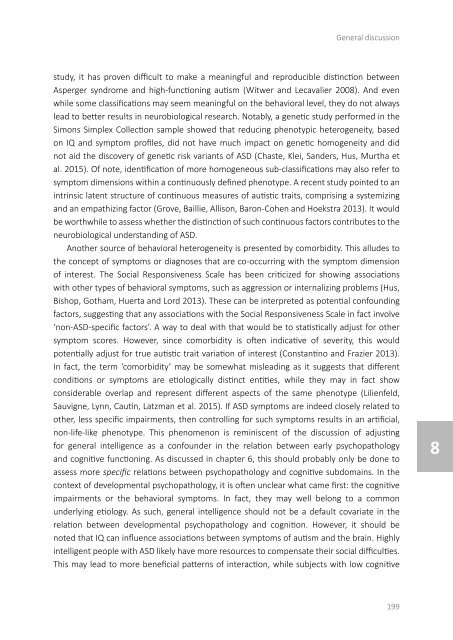On the Spectrum
2lm5UyR
2lm5UyR
Create successful ePaper yourself
Turn your PDF publications into a flip-book with our unique Google optimized e-Paper software.
General discussion<br />
study, it has proven difficult to make a meaningful and reproducible distinction between<br />
Asperger syndrome and high-functioning autism (Witwer and Lecavalier 2008). And even<br />
while some classifications may seem meaningful on <strong>the</strong> behavioral level, <strong>the</strong>y do not always<br />
lead to better results in neurobiological research. Notably, a genetic study performed in <strong>the</strong><br />
Simons Simplex Collection sample showed that reducing phenotypic heterogeneity, based<br />
on IQ and symptom profiles, did not have much impact on genetic homogeneity and did<br />
not aid <strong>the</strong> discovery of genetic risk variants of ASD (Chaste, Klei, Sanders, Hus, Murtha et<br />
al. 2015). Of note, identification of more homogeneous sub-classifications may also refer to<br />
symptom dimensions within a continuously defined phenotype. A recent study pointed to an<br />
intrinsic latent structure of continuous measures of autistic traits, comprising a systemizing<br />
and an empathizing factor (Grove, Baillie, Allison, Baron-Cohen and Hoekstra 2013). It would<br />
be worthwhile to assess whe<strong>the</strong>r <strong>the</strong> distinction of such continuous factors contributes to <strong>the</strong><br />
neurobiological understanding of ASD.<br />
Ano<strong>the</strong>r source of behavioral heterogeneity is presented by comorbidity. This alludes to<br />
<strong>the</strong> concept of symptoms or diagnoses that are co-occurring with <strong>the</strong> symptom dimension<br />
of interest. The Social Responsiveness Scale has been criticized for showing associations<br />
with o<strong>the</strong>r types of behavioral symptoms, such as aggression or internalizing problems (Hus,<br />
Bishop, Gotham, Huerta and Lord 2013). These can be interpreted as potential confounding<br />
factors, suggesting that any associations with <strong>the</strong> Social Responsiveness Scale in fact involve<br />
‘non-ASD-specific factors’. A way to deal with that would be to statistically adjust for o<strong>the</strong>r<br />
symptom scores. However, since comorbidity is often indicative of severity, this would<br />
potentially adjust for true autistic trait variation of interest (Constantino and Frazier 2013).<br />
In fact, <strong>the</strong> term ‘comorbidity’ may be somewhat misleading as it suggests that different<br />
conditions or symptoms are etiologically distinct entities, while <strong>the</strong>y may in fact show<br />
considerable overlap and represent different aspects of <strong>the</strong> same phenotype (Lilienfeld,<br />
Sauvigne, Lynn, Cautin, Latzman et al. 2015). If ASD symptoms are indeed closely related to<br />
o<strong>the</strong>r, less specific impairments, <strong>the</strong>n controlling for such symptoms results in an artificial,<br />
non-life-like phenotype. This phenomenon is reminiscent of <strong>the</strong> discussion of adjusting<br />
for general intelligence as a confounder in <strong>the</strong> relation between early psychopathology<br />
and cognitive functioning. As discussed in chapter 6, this should probably only be done to<br />
assess more specific relations between psychopathology and cognitive subdomains. In <strong>the</strong><br />
context of developmental psychopathology, it is often unclear what came first: <strong>the</strong> cognitive<br />
impairments or <strong>the</strong> behavioral symptoms. In fact, <strong>the</strong>y may well belong to a common<br />
underlying etiology. As such, general intelligence should not be a default covariate in <strong>the</strong><br />
relation between developmental psychopathology and cognition. However, it should be<br />
noted that IQ can influence associations between symptoms of autism and <strong>the</strong> brain. Highly<br />
intelligent people with ASD likely have more resources to compensate <strong>the</strong>ir social difficulties.<br />
This may lead to more beneficial patterns of interaction, while subjects with low cognitive<br />
8<br />
199


